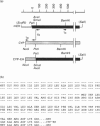Abstract
The microsomal epoxide hydrolase (mEH) catalyses the hydrolysis of reactive epoxides which are formed by the action of cytochromes P-450 from xenobiotics. In addition it has been suggested that mEH might mediate the transport of bile acids. For the mEH it has been shown that it is co-translationally inserted into the endoplasmic reticulum. Here we demonstrate that the N-terminal 20 amino acid residues of this protein serve as its single membrane anchor signal sequence and that the function of this sequence can also be supplied by a cytochrome P-450 (CYP2B1) anchor signal sequence. The evidence supporting this conclusion is as follows: (i) the rat mEH and a CYP2B1-mEH fusion protein, in which the CYP2B1 membrane anchor signal sequence replaced the N-terminal 20 amino acid residues of mEH, was co-translationally inserted into dog pancreas microsomes in a cell-free translation system, whereas a truncated epoxide hydrolase with a deletion of the 20 N-terminal amino acid residues was not co-translationally inserted. (ii) The mEH and the CYP2B1-mEH fusion protein, but not the truncated epoxide hydrolase, were anchored in microsomes in a cell-free translation system and in membrane fractions derived from fibroblasts which expressed these proteins heterologously. These fibroblasts were also used to evaluate the significance of the mEH membrane anchor for the catalytic activity of mEH. The mEH, the truncated mEH and the CYP-EH fusion protein were found to be enzymically active. This result shows that the membrane anchor signal sequence of mEH is dispensable for the catalytic activity of this protein. However, truncated mEH was only expressed at low levels, which might indicate that this protein is unstable.
Full text
PDF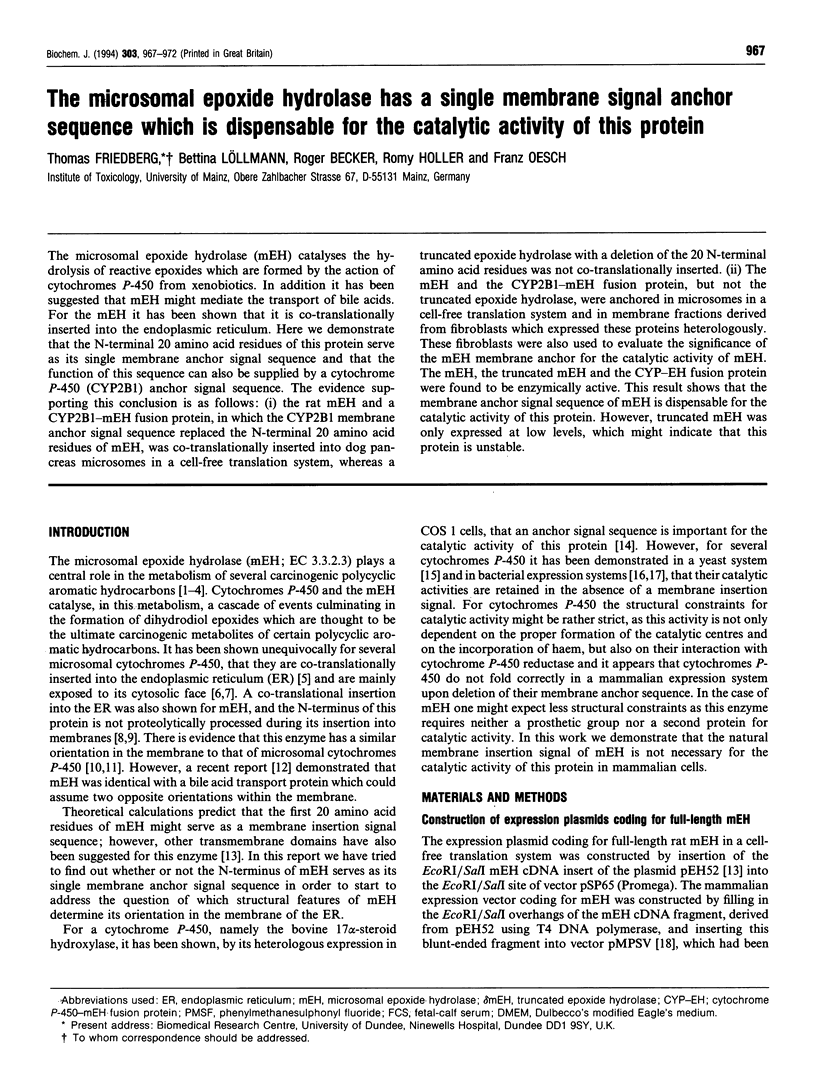
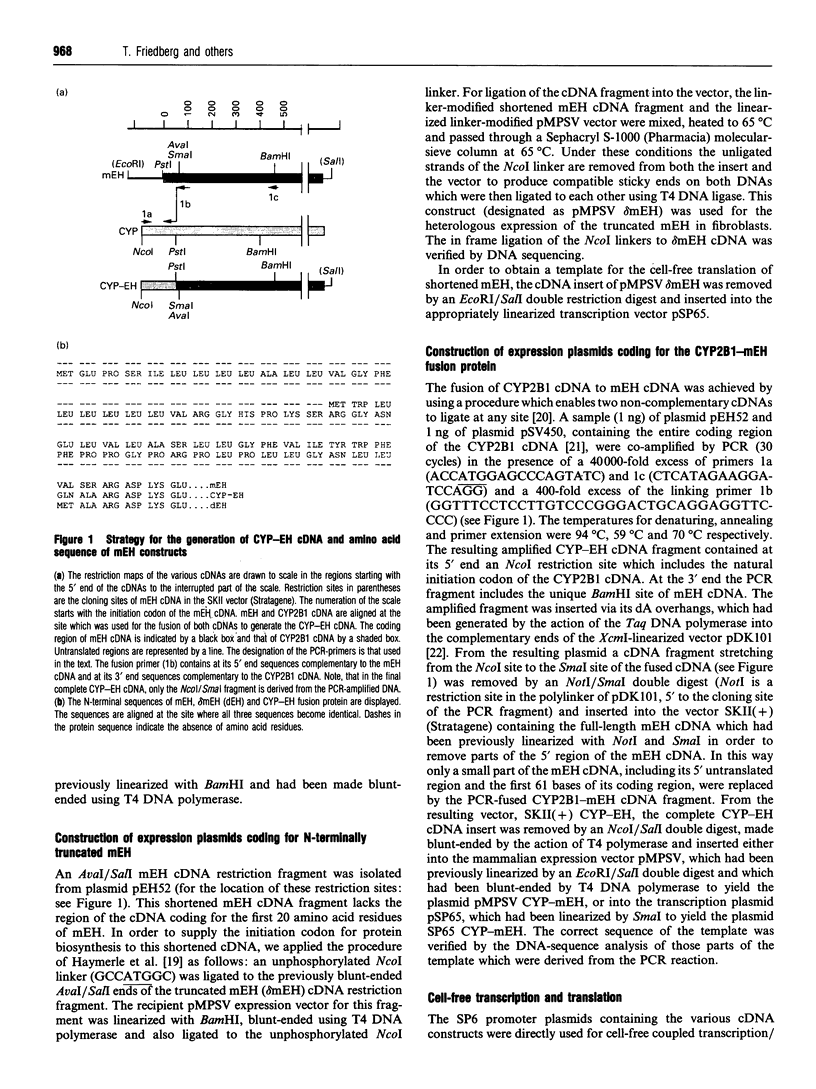
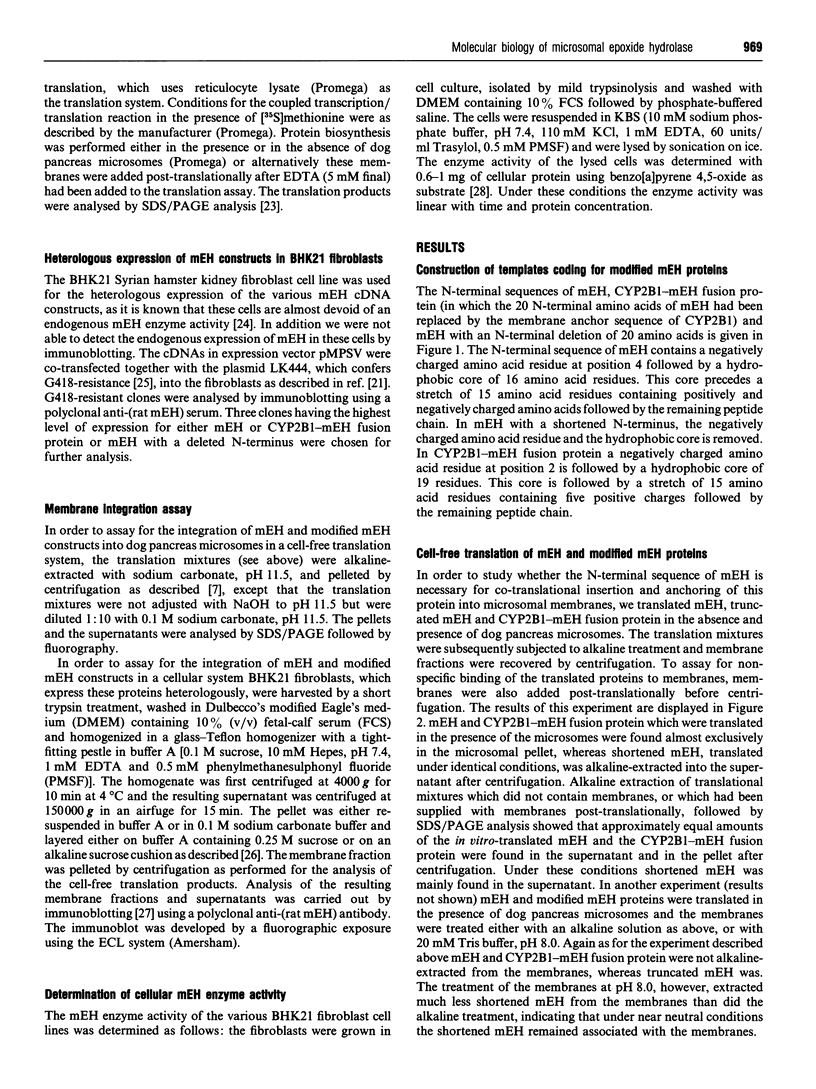
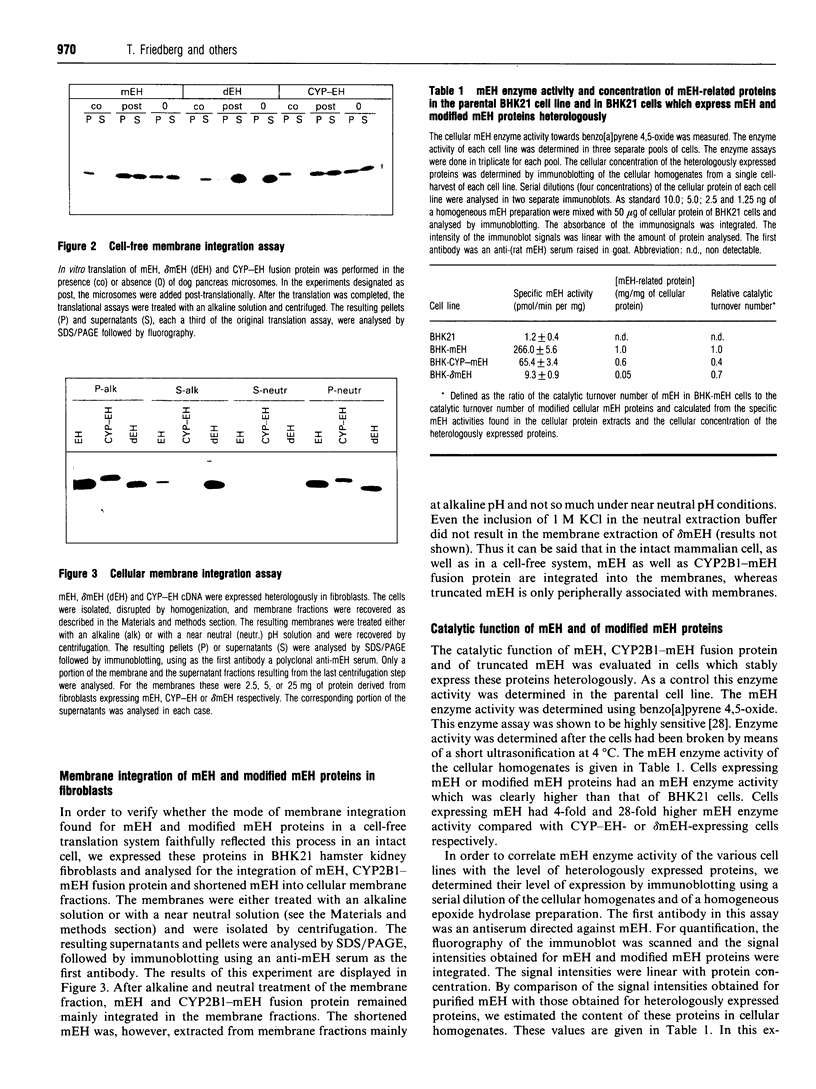
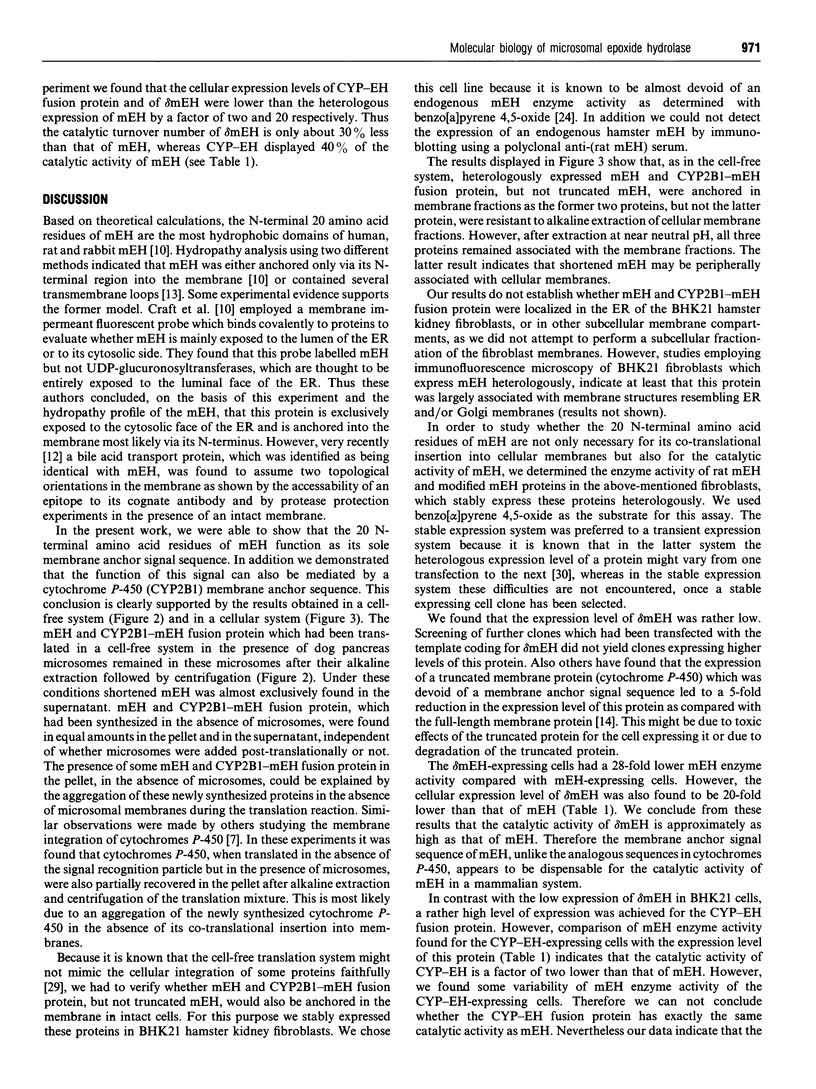
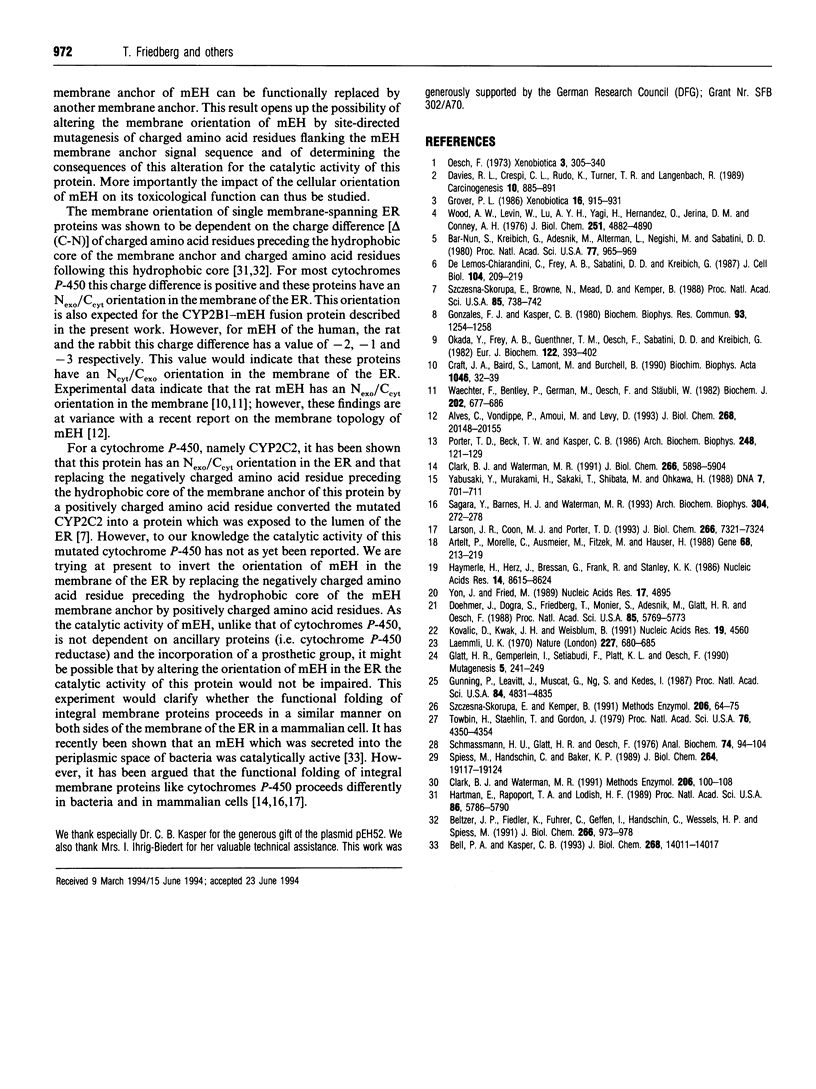
Images in this article
Selected References
These references are in PubMed. This may not be the complete list of references from this article.
- Alves C., von Dippe P., Amoui M., Levy D. Bile acid transport into hepatocyte smooth endoplasmic reticulum vesicles is mediated by microsomal epoxide hydrolase, a membrane protein exhibiting two distinct topological orientations. J Biol Chem. 1993 Sep 25;268(27):20148–20155. [PubMed] [Google Scholar]
- Artelt P., Morelle C., Ausmeier M., Fitzek M., Hauser H. Vectors for efficient expression in mammalian fibroblastoid, myeloid and lymphoid cells via transfection or infection. Gene. 1988 Sep 7;68(2):213–219. doi: 10.1016/0378-1119(88)90023-6. [DOI] [PubMed] [Google Scholar]
- Bar-Nun S., Kreibich G., Adesnik M., Alterman L., Negishi M., Sabatini D. D. Synthesis and insertion of cytochrome P-450 into endoplasmic reticulum membranes. Proc Natl Acad Sci U S A. 1980 Feb;77(2):965–969. doi: 10.1073/pnas.77.2.965. [DOI] [PMC free article] [PubMed] [Google Scholar]
- Bell P. A., Kasper C. B. Expression of rat microsomal epoxide hydrolase in Escherichia coli. Identification of a histidyl residue essential for catalysis. J Biol Chem. 1993 Jul 5;268(19):14011–14017. [PubMed] [Google Scholar]
- Beltzer J. P., Fiedler K., Fuhrer C., Geffen I., Handschin C., Wessels H. P., Spiess M. Charged residues are major determinants of the transmembrane orientation of a signal-anchor sequence. J Biol Chem. 1991 Jan 15;266(2):973–978. [PubMed] [Google Scholar]
- Clark B. J., Waterman M. R. Heterologous expression of mammalian P450 in COS cells. Methods Enzymol. 1991;206:100–108. doi: 10.1016/0076-6879(91)06081-d. [DOI] [PubMed] [Google Scholar]
- Clark B. J., Waterman M. R. The hydrophobic amino-terminal sequence of bovine 17 alpha-hydroxylase is required for the expression of a functional hemoprotein in COS 1 cells. J Biol Chem. 1991 Mar 25;266(9):5898–5904. [PubMed] [Google Scholar]
- Craft J. A., Baird S., Lamont M., Burchell B. Membrane topology of epoxide hydrolase. Biochim Biophys Acta. 1990 Aug 28;1046(1):32–39. doi: 10.1016/0005-2760(90)90091-b. [DOI] [PubMed] [Google Scholar]
- Davies R. L., Crespi C. L., Rudo K., Turner T. R., Langenbach R. Development of a human cell line by selection and drug-metabolizing gene transfection with increased capacity to activate promutagens. Carcinogenesis. 1989 May;10(5):885–891. doi: 10.1093/carcin/10.5.885. [DOI] [PubMed] [Google Scholar]
- De Lemos-Chiarandini C., Frey A. B., Sabatini D. D., Kreibich G. Determination of the membrane topology of the phenobarbital-inducible rat liver cytochrome P-450 isoenzyme PB-4 using site-specific antibodies. J Cell Biol. 1987 Feb;104(2):209–219. doi: 10.1083/jcb.104.2.209. [DOI] [PMC free article] [PubMed] [Google Scholar]
- Doehmer J., Dogra S., Friedberg T., Monier S., Adesnik M., Glatt H., Oesch F. Stable expression of rat cytochrome P-450IIB1 cDNA in Chinese hamster cells (V79) and metabolic activation of aflatoxin B1. Proc Natl Acad Sci U S A. 1988 Aug;85(16):5769–5773. doi: 10.1073/pnas.85.16.5769. [DOI] [PMC free article] [PubMed] [Google Scholar]
- Glatt H., Gemperlein I., Setiabudi F., Platt K. L., Oesch F. Expression of xenobiotic-metabolizing enzymes in propagatable cell cultures and induction of micronuclei by 13 compounds. Mutagenesis. 1990 May;5(3):241–249. doi: 10.1093/mutage/5.3.241. [DOI] [PubMed] [Google Scholar]
- Gonzalez F. J., Kasper C. B. In vitro translation of epoxide hydratase messenger RNA. Biochem Biophys Res Commun. 1980 Apr 29;93(4):1254–1258. doi: 10.1016/0006-291x(80)90624-5. [DOI] [PubMed] [Google Scholar]
- Grover P. L. Pathways involved in the metabolism and activation of polycyclic hydrocarbons. Xenobiotica. 1986 Oct-Nov;16(10-11):915–931. doi: 10.3109/00498258609038974. [DOI] [PubMed] [Google Scholar]
- Gunning P., Leavitt J., Muscat G., Ng S. Y., Kedes L. A human beta-actin expression vector system directs high-level accumulation of antisense transcripts. Proc Natl Acad Sci U S A. 1987 Jul;84(14):4831–4835. doi: 10.1073/pnas.84.14.4831. [DOI] [PMC free article] [PubMed] [Google Scholar]
- Hartmann E., Rapoport T. A., Lodish H. F. Predicting the orientation of eukaryotic membrane-spanning proteins. Proc Natl Acad Sci U S A. 1989 Aug;86(15):5786–5790. doi: 10.1073/pnas.86.15.5786. [DOI] [PMC free article] [PubMed] [Google Scholar]
- Haymerle H., Herz J., Bressan G. M., Frank R., Stanley K. K. Efficient construction of cDNA libraries in plasmid expression vectors using an adaptor strategy. Nucleic Acids Res. 1986 Nov 11;14(21):8615–8624. doi: 10.1093/nar/14.21.8615. [DOI] [PMC free article] [PubMed] [Google Scholar]
- Kovalic D., Kwak J. H., Weisblum B. General method for direct cloning of DNA fragments generated by the polymerase chain reaction. Nucleic Acids Res. 1991 Aug 25;19(16):4560–4560. doi: 10.1093/nar/19.16.4560. [DOI] [PMC free article] [PubMed] [Google Scholar]
- Laemmli U. K. Cleavage of structural proteins during the assembly of the head of bacteriophage T4. Nature. 1970 Aug 15;227(5259):680–685. doi: 10.1038/227680a0. [DOI] [PubMed] [Google Scholar]
- Larson J. R., Coon M. J., Porter T. D. Alcohol-inducible cytochrome P-450IIE1 lacking the hydrophobic NH2-terminal segment retains catalytic activity and is membrane-bound when expressed in Escherichia coli. J Biol Chem. 1991 Apr 25;266(12):7321–7324. [PubMed] [Google Scholar]
- Oesch F. Mammalian epoxide hydrases: inducible enzymes catalysing the inactivation of carcinogenic and cytotoxic metabolites derived from aromatic and olefinic compounds. Xenobiotica. 1973 May;3(5):305–340. doi: 10.3109/00498257309151525. [DOI] [PubMed] [Google Scholar]
- Okada Y., Frey A. B., Guenthner T. M., Oesch F., Sabatini D. D., Kreibich G. Studies on the biosynthesis of microsomal membrane proteins. Site of synthesis and mode of insertion of cytochrome b5, cytochrome b5 reductase, cytochrome P-450 reductase and epoxide hydrolase. Eur J Biochem. 1982 Feb;122(2):393–402. doi: 10.1111/j.1432-1033.1982.tb05894.x. [DOI] [PubMed] [Google Scholar]
- Porter T. D., Beck T. W., Kasper C. B. Complementary DNA and amino acid sequence of rat liver microsomal, xenobiotic epoxide hydrolase. Arch Biochem Biophys. 1986 Jul;248(1):121–129. doi: 10.1016/0003-9861(86)90408-x. [DOI] [PubMed] [Google Scholar]
- Sagara Y., Barnes H. J., Waterman M. R. Expression in Escherichia coli of functional cytochrome P450c17 lacking its hydrophobic amino-terminal signal anchor. Arch Biochem Biophys. 1993 Jul;304(1):272–278. doi: 10.1006/abbi.1993.1349. [DOI] [PubMed] [Google Scholar]
- Schmassmann H. U., Glatt H. R., Oesch F. A rapid assay for epoxide hydratase activity with benzo (a)pyrene 4,5-(K-region)-oxide as substrate. Anal Biochem. 1976 Jul;74(1):94–104. doi: 10.1016/0003-2697(76)90312-2. [DOI] [PubMed] [Google Scholar]
- Spiess M., Handschin C., Baker K. P. Stop-transfer activity of hydrophobic sequences depends on the translation system. J Biol Chem. 1989 Nov 15;264(32):19117–19124. [PubMed] [Google Scholar]
- Szczesna-Skorupa E., Browne N., Mead D., Kemper B. Positive charges at the NH2 terminus convert the membrane-anchor signal peptide of cytochrome P-450 to a secretory signal peptide. Proc Natl Acad Sci U S A. 1988 Feb;85(3):738–742. doi: 10.1073/pnas.85.3.738. [DOI] [PMC free article] [PubMed] [Google Scholar]
- Szczesna-Skorupa E., Kemper B. Cell-free analysis of targeting of cytochrome P450 to microsomal membranes. Methods Enzymol. 1991;206:64–75. doi: 10.1016/0076-6879(91)06077-g. [DOI] [PubMed] [Google Scholar]
- Towbin H., Staehelin T., Gordon J. Electrophoretic transfer of proteins from polyacrylamide gels to nitrocellulose sheets: procedure and some applications. Proc Natl Acad Sci U S A. 1979 Sep;76(9):4350–4354. doi: 10.1073/pnas.76.9.4350. [DOI] [PMC free article] [PubMed] [Google Scholar]
- Waechter F., Bentley P., Germann M., Oesch F., Stäubli W. Immuno-electron-microscopic studies on the subcellular distribution of rat liver epoxide hydrolase and the effect of phenobarbitone and 2-acetamidofluorene treatment. Biochem J. 1982 Mar 15;202(3):677–686. doi: 10.1042/bj2020677. [DOI] [PMC free article] [PubMed] [Google Scholar]
- Wood A. W., Levin W., Lu A. Y., Yagi H., Hernandez O., Jerina D. M., Conney A. H. Metabolism of benzo(a)pyrene and benzo (a)pyrene derivatives to mutagenic products by highly purified hepatic microsomal enzymes. J Biol Chem. 1976 Aug 25;251(16):4882–4890. [PubMed] [Google Scholar]
- Yabusaki Y., Murakami H., Sakaki T., Shibata M., Ohkawa H. Genetically engineered modification of P450 monooxygenases: functional analysis of the amino-terminal hydrophobic region and hinge region of the P450/reductase fused enzyme. DNA. 1988 Dec;7(10):701–711. doi: 10.1089/dna.1988.7.701. [DOI] [PubMed] [Google Scholar]
- Yon J., Fried M. Precise gene fusion by PCR. Nucleic Acids Res. 1989 Jun 26;17(12):4895–4895. doi: 10.1093/nar/17.12.4895. [DOI] [PMC free article] [PubMed] [Google Scholar]



